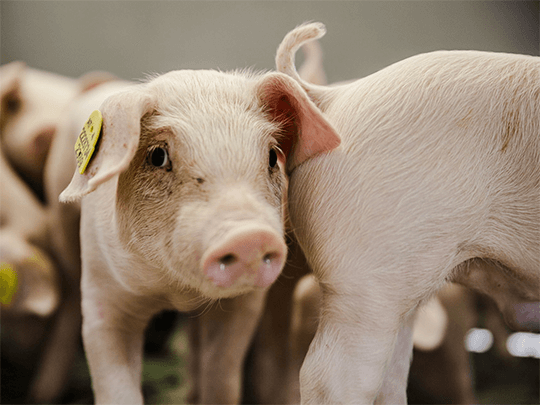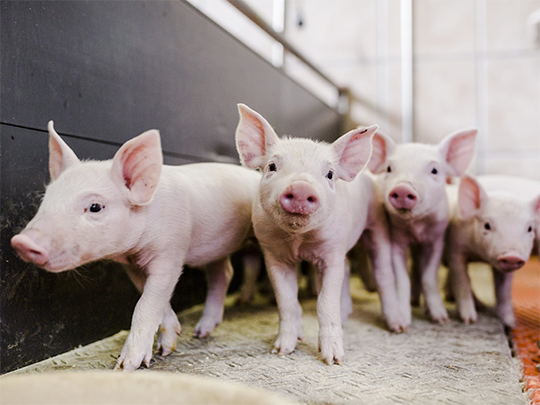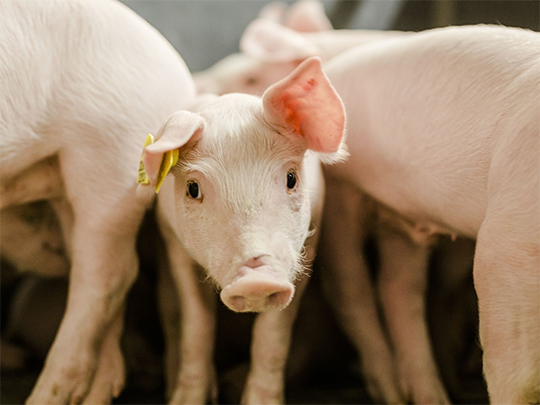Post-weaning problems in piglets?
Maintaining gut resilience is the key to success. Read in this article how selected phytogenic ingredients can help to ensure feed intake in piglets and thus support them during challenging post-weaning period.
“Dear Delacon Team, Yesterday I read in the newspaper that more and more countries are going to ban antibiotics like Colistin for therapeutic use in livestock production. Moreover, the EU is planning to ban the use of Zink-oxide in 2022. However, every 4th of my piglet dies of post weaning diarrhea (PWD) if I do not treat them with appropriate medications. With the ban of ZnO and Colistin I have no idea how to treat post-weaning problems in piglets. PWD reduces my revenue significantly. Maybe, the right approach to maintain my piglets healthy is by strengthening their intestine? That’s why I’m addressing you. Do you have a natural solution to support my piglets during the stressfull post-weaning period?“

Dear Eric, not only your farm is affected by post-weaning problems in piglets.
Its assumed that in Europe 15-23% of all piglets are affected by post-weaning problems, like a reduced feed intake post weaning or post-weaning diarrhea (PWD) causing considerable losses in turnover of piglet producers.
As you have already recognized, alternative approaches, like phytogenics, can help to support piglets during the challenging post-weaning period by supporting feed intake and maintaining normal gut resilience – although they cannot prevent the occurence of PWD.
The weaning process: the most stressful period in piglets early life
Throughout the weaning process, piglets are exposed to high stress conditions: it is separated from its mother and put into a new environment with piglets from other litters. Moreover, the diet changes from highly digestible sow milk, to solid, less digestible feed. Thus, the feed intake and daily weight gain decreases.
The intestine and especially the gut microflora are not yet matured. Thus, bacteria from the barn environment can easily penetrate the intestinal mucous membrane. Particularly enterotoxigenic E. coli, better known as ETEC, are the triggers of PWD. Thereby, a single E. coli cannot provoke the outbreak of the disease: However, if the bacterial population in the intestine increases, the communication between the several bacteria intensifies.

But what does this “communication”, called quorum sensing, look like?
Some types of bacteria produce signal molecules which diffuse into adjacent bacterial cells of the same strain – if the density of signal molecules and bacteria reaches a certain threshold. In the bacterial cell, those signal molecules induce the expression of specific genes. In ETEC for example, specific pathogenic factors are produced: attachment factors and toxins. These attachment factors allow ETEC to stick to piglets’ intestinal cells. The produced enterotoxins may lead to discharge of electrolytes, which can result in massive water loss into the intestinal lumen. Diarrhea outbreak in the piglet may start and the animals literally “dry out”.
Since the piglet’s immune system is not fully matured at this time, it may need additional support for maintaing gut resilience during the challenging post-weaning period.

Especially the post-weaning period is a critical phase for the later development of the piglet. A reduction in feed intake favours the appearance of post-weaning problems in piglets and may lead to decreased performance of the piglet.
The farmer’s sales can decline – not only due to rising medication costs. Thus, an effective strategy of maintaining the piglets´ resilience and ensuring feed intake during stressful conditions is indicated. In particular, the wide spectrum of physiological modes of action of phytogenics offers a unique approach to support the maintenance of normal intestinal health of the piglet during the post-weaning period– convince yourself:

5 ways how phytogenics can help to support maintenance of normal gut resilience in weaned piglets
1. Increased daily gain due to improved palatability of the feed, thus also achieving an increased body weight at the end of the weaning period and supporting piglet’s resilience during post-weaning challenges
2. Support of nutrient digestion and nutrient uptake, due to fostered activity of nutrient transporters in the intestinal lumen
3. Several phytogenic substances have shown to reduce pathogen adhesion and expression of virulence genes by Quorum sensing inhibition
4. Supporting a balanced intestinal microflora due to plant-based mucilages, and thereby contributing to support the maintenance of intestinal integrity
What does that mean for the piglets? The animal gets the best possible natural support in this critical phase of life. Consequently, also the farmer benefits: Through a supported feed intake and nutrient digestibility, the piglet is supported even in the challenging post-weaning period. This can mean substantial savings for the farmer.
References available upon request

Anne Oberdorf
Anne has always been fascinated by the unknown, the diversity and beauty of nature. Her love for nature brought her to Delacon in 2018 after studying agricultural sciences, where she worked as Technical Communications Manager and later as Product Manager Aquaculture. Since February 2021, she has been taking a new, natural career path outside of Delacon.










